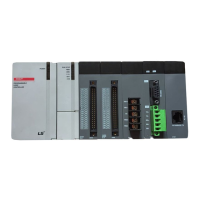Chapter 5 Memory and Parameter
(f) Encoder speed unit
This is used to set the speed display unit of the encoder and sets the reference unit of the speed value.
When set to '0: Unit/sec', it is applied as the rate of change per second of the unit position set in ‘Unit’ parameter. For example, if
the ‘Unit’ setting is mm, the speed display unit is 'mm/s'.
When set to '1: Unit/min', it is applied as the rate of change per minute of the corresponding unit position set in ‘Unit’ parameter.
For example, if the ‘Unit’ setting is mm, the speed display unit is 'mm/min'.
When set to ‘2: rpm’, it is applied as the rpm. To display the rpm, it is used the values set in the ‘Number of pulses per rotation’
and ‘Travel distance per rotation’ parameter.
(g) Encoder input filter value
Set the filter value to limit the frequency of the pulse input to the encoder.
Possible values are 0 ~ 6 and the meaning of each value is as follows.
0: Does not limit the frequency of pulses input to the encoder.
1: Limit the frequency of the pulse input to the encoder to 500 kPPS.
2: Limit the frequency of the pulse input to the encoder to 200kPPS.
3: Limit the frequency of the pulse input to the encoder to 100kPPS.
4: Limit the frequency of the pulse input to the encoder to 10kPPS.
5: Limit the frequency of the pulse input to the encoder to 1kPPS.
6: Limit the frequency of the pulse input to the encoder to 0.2kPPS.
(h) Encoder position filter time constant
Set the time for calculating the position average of the encoder input from the outside. (Unit: ms) When set to '0', the position filter
time constant is not applied.
If the deviation of the current position is severe, such as when the ‘Unit’ setting of the encoder is ‘0: pulse’, a stable position can
be obtained by applying the position average to the current position.
The following is the trace of the current position input from the external encoder. You can check the difference of the trace
position according to the position filter time constant value.

